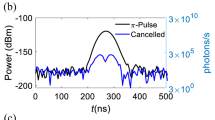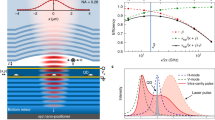Abstract
Photons are critical to quantum technologies because they can be used for virtually all quantum information tasks, for example, in quantum metrology1, as the information carrier in photonic quantum computation2,3, as a mediator in hybrid systems4, and to establish long-distance networks5. The physical characteristics of photons in these applications differ drastically; spectral bandwidths span 12 orders of magnitude from 50 THz (ref. 6) for quantum-optical coherence tomography7 to 50 Hz for certain quantum memories8. Combining these technologies requires coherent interfaces that reversibly map centre frequencies and bandwidths of photons to avoid excessive loss. Here, we demonstrate bandwidth compression of single photons by a factor of 40 as well as tunability over a range 70 times that bandwidth via sum-frequency generation with chirped laser pulses. This constitutes a time-to-frequency interface for light capable of converting time-bin to colour entanglement9, and enables ultrafast timing measurements. It is a step towards arbitrary waveform generation10 for single and entangled photons.
This is a preview of subscription content, access via your institution
Access options
Subscribe to this journal
Receive 12 print issues and online access
$209.00 per year
only $17.42 per issue
Buy this article
- Purchase on Springer Link
- Instant access to full article PDF
Prices may be subject to local taxes which are calculated during checkout




Similar content being viewed by others
References
Higgins, B. L., Berry, D. W., Bartlett, S. D., Wiseman, H. M. & Pryde, G. J. Entanglement-free Heisenberg-limited phase estimation. Nature 450, 393–396 (2007).
Kok, P. et al. Linear optical quantum computing with photonic qubits. Rev. Mod. Phys. 79, 135–174 (2007).
Aspuru-Guzik, A. & Walther, P. Photonic quantum simulators. Nature Phys. 8, 285–291 (2012).
Wallquist, M., Hammerer, K., Rabl, P., Lukin, M. & Zoller, P. Hybrid quantum devices and quantum engineering. Phys. Scr. 2009, 014001 (2009).
Duan, L.-M., Lukin, M. D., Cirac, J. I. & Zoller, P. Long-distance quantum communication with atomic ensembles and linear optics. Nature 414, 413–418 (2001).
Nasr, M. B. et al. Ultrabroadband biphotons generated via chirped quasi-phase-matched optical parametric down-conversion. Phys. Rev. Lett. 100, 183601 (2008).
Abouraddy, A. F., Nasr, M. B., Saleh, B. E. A., Sergienko, A. V. & Teich, M. C. Quantum-optical coherence tomography with dispersion cancellation. Phys. Rev. A 65, 053817 (2002).
Tittel, W. et al. Photon-echo quantum memory in solid state systems. Laser Photon. Rev. 4, 244–267 (2010).
Ramelow, S., Ratschbacher, L., Fedrizzi, A., Langford, N. K. & Zeilinger, A. Discrete tunable color entanglement. Phys. Rev. Lett. 103, 253601 (2009).
Kielpinski, D., Corney, J. F. & Wiseman, H. M. Quantum optical waveform conversion. Phys. Rev. Lett. 106, 130501 (2011).
Eisaman, M. D., Fan, J., Migdall, A. & Polyakov, S. V. Invited review article: single-photon sources and detectors. Rev. Sci. Instrum. 82, 071101 (2011).
Hosseini, M., Sparkes, B. M., Campbell, G., Lam, P. K. & Buchler, B. C. High efficiency coherent optical memory with warm rubidium vapour. Nature Commun. 2, 174 (2011).
Huang, J. & Kumar, P. Observation of quantum frequency conversion. Phys. Rev. Lett. 68, 2153–2156 (1992).
Vandevender, A. P. & Kwiat, P. G. High efficiency single photon detection via frequency up-conversion. J. Mod. Opt. 51, 1433–1445 (2004).
Tanzilli, S. et al. A photonic quantum information interface. Nature 437, 116–120 (2005).
Langrock, C. et al. Highly efficient single-photon detection at communication wavelengths by use of upconversion in reverse-proton-exchanged periodically poled LiNbO3 waveguides. Opt. Lett. 30, 1725–1727 (2005).
Ramelow, S., Fedrizzi, A., Poppe, A., Langford, N. K. & Zeilinger, A. Polarization-entanglement-conserving frequency conversion of photons. Phys. Rev. A 85, 013845 (2012).
Rakher, M. T. et al. Simultaneous wavelength translation and amplitude modulation of single photons from a quantum dot. Phys. Rev. Lett. 107, 083602 (2011).
McGuinness, H. J., Raymer, M. G., McKinstrie, C. J. & Radic, S. Quantum frequency translation of single-photon states in a photonic crystal fiber. Phys. Rev. Lett. 105, 093604 (2010).
Dudin, Y. O. et al. Entanglement of light-shift compensated atomic spin waves with telecom light. Phys. Rev. Lett. 105, 260502 (2010).
Pelc, J. S. et al. Long-wavelength-pumped upconversion single-photon detector at 1550 nm: performance and noise analysis. Opt. Express 19, 21445–21456 (2011).
Lvovsky, A. I., Sanders, B. C. & Tittel, W. Optical quantum memory. Nature Photon. 3, 706–714 (2009).
Liu, C., Dutton, Z., Behroozi, C. H. & Vestergaard Hau, L. Observation of coherent optical information storage in an atomic medium using halted light pulses. Nature 409, 490–493 (2001).
Boyd, R. W. Nonlinear Optics 3rd edn (Academic Press, 2008).
Raoult, F. et al. Efficient generation of narrow-bandwidth picosecond pulses by frequency doubling of femtosecond chirped pulses. Opt. Lett. 23, 1117–1119 (1998).
Osvay, K. & Ross, I. N. Efficient tuneable bandwidth frequency mixing using chirped pulses. Opt. Commun. 166, 113–119 (1999).
Veitas, G. & Danielius, R. Generation of narrow-bandwidth tunable picosecond pulses by difference-frequency mixing of stretched pulses. J. Opt. Soc. Am. B 16, 1561–1565 (1999).
Simon, C. et al. Quantum memories. Eur. Phys. J. D 58, 1–22 (2010).
Reim, K. F. et al. Towards high-speed optical quantum memories. Nature Photon. 4, 218–221 (2010).
Eckstein, A., Brecht, B. & Silberhorn, C. A quantum pulse gate based on spectrally engineered sum frequency generation. Opt. Express 19, 13770–13778 (2011).
Baek, S.-Y., Cho, Y.-W. & Kim, Y.-H. Nonlocal dispersion cancellation using entangled photons. Opt. Express 17, 19241–19252 (2009).
Treacy, E. Optical pulse compression with diffraction gratings. IEEE J. Quantum Electron. 5, 454–458 (1969).
Diels, J.-C. & Rudolph, W. Ultrashort Laser Pulse Phenomena 2nd edn (Academic Press, 2006).
Acknowledgements
The authors thank A. Branczyk, D. Hamel, A. Kallin, R. Melko, M. Piani, R. Prevedel, S. Ramelow, K. Shalm and J. Watrous for helpful discussions. The authors acknowledge financial support from the Natural Sciences and Engineering Research Council of Canada (NSERC), the Ontario Centres of Excellence (OCE), the Canada Foundation for Innovation (CFI), QuantumWorks, the Ontario Graduate Scholarship Program (OGS) and the Ontario Ministry of Research and Innovation Early Researcher Award.
Author information
Authors and Affiliations
Contributions
A.F. and K.J.R. conceived the idea for the study. K.J.R., A.F. and J.L. designed the experiment. J.L. performed the experiments and analysed the data. J.M.D. and L.G.W. contributed to building the experimental setup and in taking data. All authors contributed to writing the manuscript. A.F. is supported by an ARC Discovery Early Career Researcher Award DE130100240.
Corresponding authors
Ethics declarations
Competing interests
The authors declare no competing financial interests.
Supplementary information
Supplementary information
Supplementary information (PDF 821 kb)
Rights and permissions
About this article
Cite this article
Lavoie, J., Donohue, J., Wright, L. et al. Spectral compression of single photons. Nature Photon 7, 363–366 (2013). https://doi.org/10.1038/nphoton.2013.47
Received:
Accepted:
Published:
Issue Date:
DOI: https://doi.org/10.1038/nphoton.2013.47
This article is cited by
-
Interface between picosecond and nanosecond quantum light pulses
Nature Photonics (2023)
-
Spectral control of nonclassical light pulses using an integrated thin-film lithium niobate modulator
Light: Science & Applications (2022)
-
Spectrally reconfigurable quantum emitters enabled by optimized fast modulation
npj Quantum Information (2020)
-
Polarization insensitive frequency conversion for an atom-photon entanglement distribution via a telecom network
Nature Communications (2018)
-
Spectral compression of single-photon-level laser pulse
Scientific Reports (2017)



